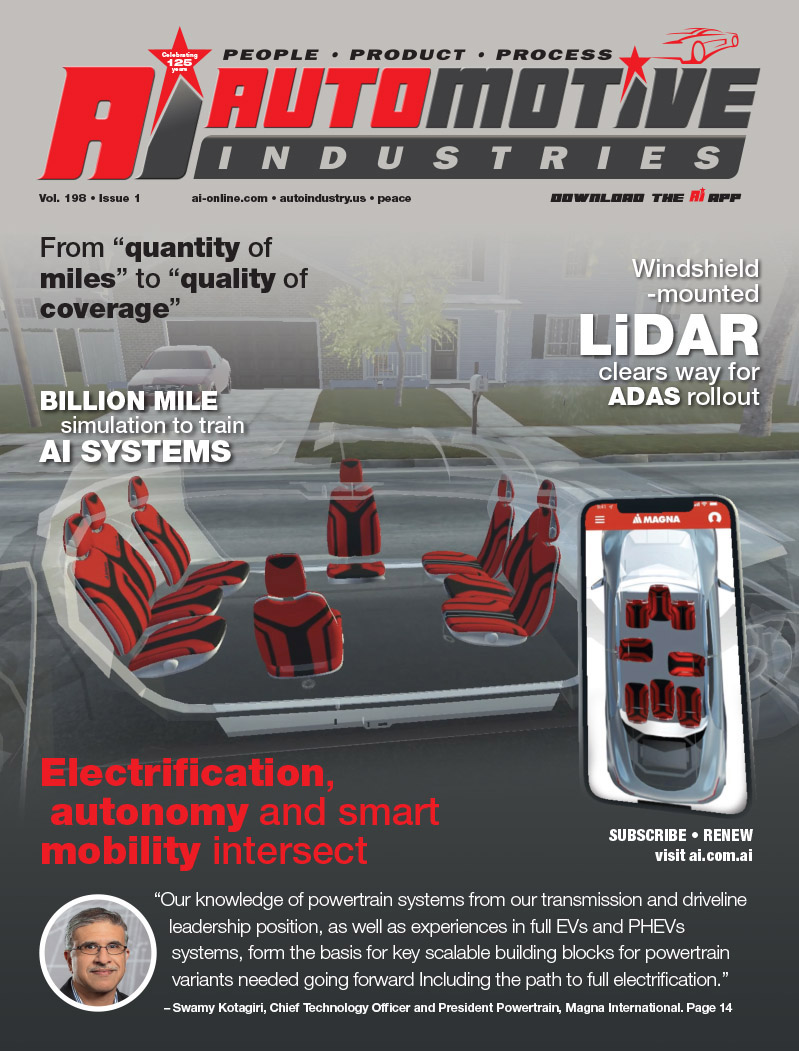
Earlier this year, Data I/O Corporation announced that a Japan-based multinational automotive supplier had selected its FLX500 automated desktop programming solution for its Eastern European production plants. The company manufactures electro-mechanical switching and audio car electronics. “The FLX500 was selected after a careful study of device programming alternatives and was chosen for its excellent fit with the mix and volume needs of our customer. The flexibility of this desktop system, ease of use, and cost-effectiveness over outsourcing and on-board programming were major factors in the selection. This important win further strengthens our growing family of leading automotive customers,” said Harald Weigelt, vice president of worldwide sales and support at Data I/O.
In 2007, the company had launched its Automotive Performance Programming System (APPS). The automotive solution is based on the PS Series platform and is tailored for automotive original equipment manufacturers as well as Tier 1 and 2 makers of automotive electronics systems. This is expected to give Data I/O a major advantage in the automotive electronics market that is expected to touch USD 35 billion by 2010. Some of the key features of Data I/O’s APPS include features that help create a complete solution for automotive manufacturers. For example, the PS FlashCORE Remote Monitoring application provides managers or clients responsible for production processing residing in remote locations a real-time direct link to the programming activities on the factory floor. Customers can view up to five networked programming systems and monitor the current production activity and yield statistics.
“The Automotive Performance Programming System grew out of our work with automotive customers such as Lear, Hella, Bosch, Delphi, Visteon, Siemens VDO, and Kostal that were shifting from the use of mask-programmed microcontrollers to the use of programmable microcontrollers and Flash memories. In many of these companies, the design and production engineers were unfamiliar with the issues related to data file management, firmware control, and the creation of secure production processes with programmable devices. The APPS clarifies the process and helps bridge the gap between the NPI (or Advance Manufacturing) teams and the production floor,” said Fred Hume, chief executive officer, Data I/O Corporation in an earlier interview to AI.
The APPS is Data I/O’s complete automotive industry solution for off-line programming. Whereas other products are targeted at specific needs the APPS brings them all together in one solution. Individual features of the APPS, such as SPC job logging, remote monitoring, and serial number labeling, were developed at the request of automotive customers and their programming centers, to meet industry requirements for quality, traceability, and version control, says Data I/O. The APPS solution provides that level of control and traceability, both at NPI and throughout the life of the end product. The company also offers the ProLine RoadRunner, that mounts directly on the SMT machine, to provide ‘Just-in-Time’ programming the moment before the device is placed on the circuit board. This eliminates the need for reprogramming when software changes.
Automotive Industries caught up with Fred Hume, chief executive officer, Data I/O Corporation
AI: What’s new for Data I/O at this year’s SAE show?
Data I/O will display the ProLINE-RoadRunner solution designed to just-in-time programming. The Roadrunner attaches to pick-and-place machine to program devices at virtually the last possible stage of manufacturing – at the point of placement on a circuit board. This solution eliminates the inventory associated with pre-programmed Microcontroller and Flash Memory devices. It reduces process steps, eliminates the risk that firmware changes will make the pre-programmed devices unusable, and prevents interruptions in the flow of devices. If the pre-programming is being outsourced to a programming center, inventory float may be reduced by a week or more.
RoadRunner also has an advantage over the other alternative that is programming at the last stage of the manufacturing process: the testing stage. Most test equipment that is available today is not designed for high-speed programming of large Flash Memory files so bottlenecks at test are frequent. Moreover, a defective Flash device would not be identified until the device was already installed, causing an entire board to be scrapped or reworked. RoadRunner verifies the functionality of each device immediately after programming, to ensure that the device is not defective and that the programming was successful. Failed devices are moved to a reject bin.
Also on display will be the FLX500 automated programming system that fits onto a desktop. It fits well into those applications where the volume of devices to be programmed is moderate and minimum changeover time is important because of moderately high product mix. The FLX500 provides the same high quality programming environment as our larger automated systems but offers a much lower price point so is an excellent alternative to error-prone manual programming operations.
AI: Last year, the APSS was a big draw, what are some of the new products and innovations that we can expect this year from Data I/O?
FlashCORE II with boost technology
New for 2008 is the FlashCORE II programming engine with Flash boost technology. The FlashCORE II programmer is designed to support the most advanced microcontroller and memory (NAND and NOR) devices and is available in all of our automated programming solutions including the RoadRunner, the PS family, and the FLX500. As automotive electronic systems become more sophisticated, the file sizes grow. This increases programming time and can impact the takt time of the production line. FlashCORE II’s boost technology provides a dramatic improvement in programming speed for high density NAND Flash devices. For example, using ProLINE-RoadRunner a Samsung K9F2G08UOM-P (2Gbit) device without boost technology takes 151.3 seconds to program/verify 4 devices. With boost technology the program/verify time is just 32.1 seconds, a boost advantage of 470%.
The PS-Automotive Performance Pak
Data I/O is also introducing its Automotive Performance Pak for the PS-series of automated offline programming systems. It includes application specific software tools designed to assist automotive suppliers trace, monitor, and control the flow of programmable devices from inventory through production. This capability is vital to the prevention of programming errors that could lead to a product recall. If a product recall becomes necessary because of a software bug at some revision level, the software tools allow the user to identify only those products by serial number that are specifically affected.
Its Flash Version Control component creates an ‘archived job’ file containing references to all software components used in the initial Job creation. An attempt to run the archived job will provide information to the machine operator, allowing reinstatement of the approved environment including initial versions system software, process control software, algorithm and data file. This assures conformance to the original machine configuration.
The Remote Monitor software provides production manages with a direct link to programming activities. Production managers can monitor PS systems remotely and view current job status including devices passed, failed and yield percentages.
Enhanced Statistical Process Control (SPC) tracks the motion of each programmable device and together with system status is recorded in a delimited-text file. This file can be exported to an Access/Excel database or to proprietary SPC tools for process analysis and quality improvements.
Label Generator enables the design and printing of labels for reels of preprogrammed devices. Managers can track programmed components with a barcode ID, to facilitate item tracking in inventory through production. Users customize their own label type with job details including Checksum, Job name, Date, Time, Device name and the actual quantity on the reel.
Confirm Device Input validates that a new reel of devices provided to the programming system match the selected job since many programming jobs contain multiple vendors/versions of the same device as a second source. It’s critical to eliminate any possibly of error during an input reel changeover since each device has its own unique algorithm used for programming. Machine operators are prompted to validate that the correct device is being provided to the programming system. The user scans the new reel to confirm match of new devices defined in the job.
AI: What is the implication for Data I/O in having a major Japanese auto firm chose the FLX500 automated desktop?
Japanese customers typically spend considerable time evaluating new solutions, methods and processes. They are looking for long-term reliability and dependability. We believe that the ALPS order opens the door for additional business opportunities in Japan. The FLX500 is a new solution for automotive electronics manufacturers so this order provides an important reference account for third-party endorsements.
AI: Is your company’s approach different when dealing with international customers? If so, how and what are some of the product adaptations you have had to make for these customers?
Our international customers are looking for solutions that are easy-to-learn, easy-to-use and that require a minimum of process integration to adopt. For the FLX500, Data I/O created a language independent graphical user interface that minimizes training time and reduces the cost of adoption.
AI: What are some of the current challenges facing the in-vehicle electronics market today and what is Data I/O’s strategy in dealing with these problems?
Industry experts predict that by 2010 nearly ninety percent of automotive innovations will be software driven with the number of programmable microcontrollers and Flash memories per vehicle growing rapidly. The automobile is becoming a very complex electronic system on a grand scale. Every piece of this software must be develop, deployed, and maintained at a very high quality level otherwise the high cost of warranty failures makes the business unprofitable and a product recall could destroy a company. As a result we see many changes in the way electronic systems are designed and specified.
For example, for a number of years now, DVD players have been used to provide the navigation system database. These players, being optical/mechanical systems have difficulty surviving the hostile environments encountered by some vehicles. Most manufacturers have plans to switch to solid state players that use portable memory such as SD or MMC cards to contain the database. Data I/O’s new Flash Media Duplication system provides a solution for duplicating these memory cards for the navigation system manufacturers.









More Stories
Dürr and GROB concept battery factory uses 50% less production space
DuPont materials science advances next generation of EV batteries at The Battery Show
Cybord warns of dangers of the stability illusion